
12 minute read
UNDERSTANDING NURSING RESEARCH
The Duke University School of Nursing (DUSON ) is a leader in accelerating the discovery and translation of knowledge and innovation that impact care delivery. The school currently conducts over 70 nursing research projects that span the care continuum and seek to increase knowledge, improve patient outcomes, and inform evidence-based practice.
Positioned as a preeminent institution committed to nursing science, the school is leveraging its resources and infrastructure to support a significant and sustained increase in the generation and oversight of nursing research concepts and projects.
Recognizing nursing research is a key driver in delivering quality, effective health care and promoting health, Duke Health Chancellor A. Eugene Washington, MD, MPH, M.Sc., and School of Nursing Dean Marion E. Broome, PhD, RN, FAAN, have established A Challenge for Investment: Accelerating Nursing Research, a $1 million challenge fund to accelerate translational research within the Duke University School of Nursing. With these matching funds, this program will enable individual donors to support funding for start-up, pilot, and bridge funding that will ultimately attract additional sustained research support, doubling the value and impact of philanthropic contributions designated for research in the School of Nursing. The goal of this challenge is to build a pool of $2 million in unrestricted and targeted research funding by 2022.
THE GOAL:
The primary objectives of nursing and medical research are the same: improving the patient experience of care, improving the health of populations, and improving health outcomes. Where medical research focuses on developing new treatments or medications and identifying causes of illness, nursing research focuses on building the body of knowledge to identify evidence-based practices that will improve how a patient responds to treatments and their quality of life following acute and chronic illnesses.
Our emphasis on research also aligns with the Translating Duke Health initiative—a multi-disciplinary, multi-year initiative created by Chancellor Washington, to harness the expertise and knowledge found at Duke to address society’s most significant scientific and health care challenges and fulfill the vision of making discoveries and transforming health for millions. Translating Duke Health is a platform of resources—including people, services, technology, infrastructure and funding—focusing on areas where Duke Health can have the greatest impact on transformative treatments and prevention strategies. This, in turn, will accelerate and energize an enhanced environment of partnership and integration among the scientific, clinical, population health, big data science, and computing communities across Duke.
top 10
more than $5.2 M
A major nursing research institution, the school has ranked among the top 10 since 2014 in National Institutes of Healthfunded research
The school received more than $5.2 million in annual funds from the NIH in 2018, making it 8th among nursing schools engaged in NIHfunded research
TOP 5 BEST U.S.News & World Report Rankings
Currently, eight of the school’s nursing programs are ranked in the top 5 by U.S. News & World Report
#2
The school also ranked #2 in the nation as the overall best graduate school for nursing for the second year in a row
The following pages illustrate the conceptual areas of research excellence in the School of Nursing, showcasing the direct effect we have on improving health care and changing lives.
I. II. III. IV. Advancing Health Care Through Innovation Improving Health Outcomes Customizing Patient Care Preventing Disease
CONTACT US TO LEARN MORE ABOUT HOW YOU CAN TRANSFORM LIVES THROUGH NURSING RESEARCH: School of Nursing Development and Alumni Affairs: DUSONalumni@duke.edu
Research in this area drives innovation and improvements to the standard of care for patients. In order to substantively advance the quality of health care, we must consider alternative types of care and care delivery through clinical innovations.
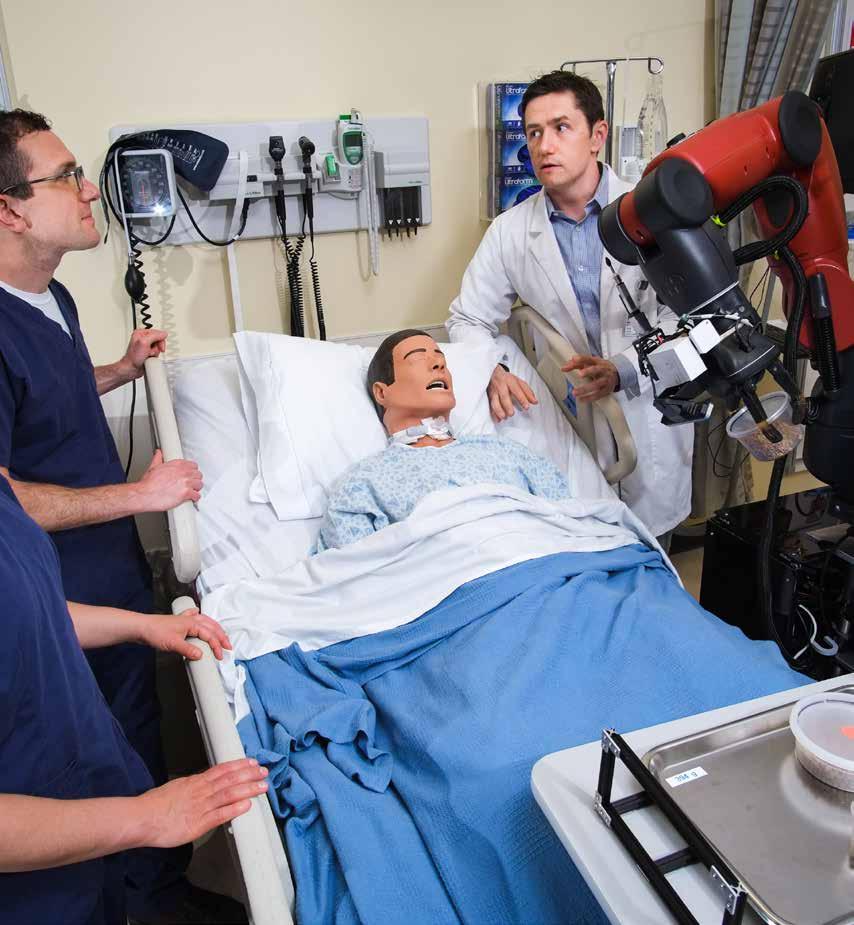
1.
ADVANCING HEALTH CARE THROUGH INNOVATION
GOAL:
Drive innovation in health care that prevents disease, optimizes personalized treatment, and improves the quality of patient care.
In order to substantively advance the quality of health care, we must consider alternative types of care and care delivery through clinical innovations. Innovations in health care will prevent disease and optimize personalized treatment and disease management for each patient.
This area of research builds upon the school’s existing expertise in patient-centered care. Research surrounding clinical innovations brings together teams of individuals with diverse perspectives and specialized knowledge to solve specific problems by creating new technologies and care models for improving health care quality and efficiency.
OUTCOME:
Investments in this area will support research that creates new ideas, innovations, products, procedures, or interventions and health system changes to benefit the health of individuals and populations.
RESEARCH IN ACTION:
ICU palliative care training Mobile monitoring Innovation and testing
ADVANCING HEALTH CARE THROUGH INNOVATION
Research in Action
Mobile monitoring
Type 2 diabetes is a serious problem in the U.S., and self-management is critical to diabetes control. However, accurate, timely information for monitoring and self-management is notably absent from the current health care system. Ryan Shaw, PhD, RN, is integrating wearable sensors, such as those found in smart phones and smart watches, as care delivery tools. His research uses these devices to collect real-time data from patients that will allow clinicians to better understand illness dynamics, improve health outcomes, and deliver personalized care in between clinic visits. Results from his work are leading to computer algorithms that will help guide patients to self-manage their diabetes while at home using mobile health technologies, and the ability for clinicians to predict changes in their patients’ diabetes-related health by incorporating data from these technologies in the electronic health record.

ICU palliative care training
Hundreds of thousands of patients and their families struggle with physical symptoms, emotional distress, and end-of-life decision making in the Intensive Care Unit (ICU) setting. Sharron Docherty, PhD, PNP-BC, FAAN, will address that problem using a digital bedside tool that will overcome clinical barriers and provide the seamless delivery of high-quality ICU-based palliative care. This electronic patient-reported system will allow families to report both need and outcomes at the bedside or at home.
Innovation and testing
Safely moving patients in and out of bed is a major issue for health care workers. Current mobility devices are slow and often require two or more caretakers to use. Critically ill patients often have many therapeutic connections at the bedside that can easily become disorganized and tangled during moves. Tangled connections lead to contamination or nurse confusion and can increase risk of falls for both nurses and patients. The Health Innovation Lab (photo page 6) extensively researches best methods to safely move patients. The Lab tests new technologies and care delivery processes in both real and simulated clinical environments. Research from the Lab has led to internal and external funding, product licensing, and company formation.

Research in areas that seek to improve health outcomes for populations address the social determinants of health and seek proactive interventions to slow or stop a disease from occurring. Instead of simply treating the patient, research in population health involves trying to prevent people from becoming patients in the first place.


2.
IMPROVING HEALTH OUTCOMES
GOAL:
Improve health outcomes for populations, address the social determinants of health, and seek proactive interventions to slow or stop a disease
Instead of simply treating the patient, population health seeks to prevent people from becoming patients in the first place. This type of care widens the lens and looks at a patient not just as a human being, but as someone who is a part of a larger community and how belonging to that community may affect their health and the health of all its members.
This research focus will find answers to challenges from disease prevention to palliative care, examining an entire range of factors that determine health and health outcomes for individuals, families, and communities across lifespans.
OUTCOME:
Investments in this area will support research that improves health outcomes for a specific group of individuals, families, or communities, and reduces health disparities within the group.
RESEARCH IN ACTION:
Smoking cessation Improving hip fracture outcomes Caregiver training and support
IMPROVING HEALTH OUTCOMES
Research in Action
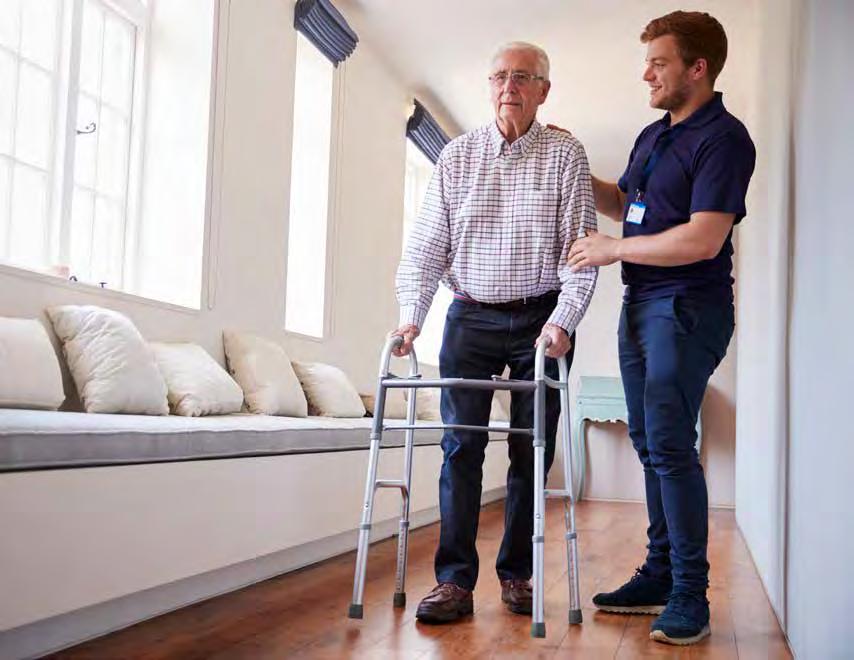
Improving hip fracture outcomes
More than 300,000 older adults—those 65 years of age and older—are hospitalized for hip fractures. One in four older adults will die within 12 months of suffering a hip fracture. Hospital readmission of these patients nearly doubles their 1-year mortality risk. Michael Cary, PhD, RN, and his team are using electronic health data and novel machine learning algorithms to predict future outcomes for patients with a hip fracture—including their likelihood of functional recovery, risk for complications, and hospital readmission. Results from his research will enable health care providers to intervene early and refer patients for more intensive rehabilitation services so adverse outcomes can be prevented.
Smoking cessation
Adults face increased challenges to quitting tobacco—withdrawal symptoms, ingrained habitual use, and limited access to consistent treatment, and need an intervention method that targets these challenges. Devon Noonan, PhD, MPH, FNP-BC, is leading a team of scientists who have created a text-message-based tobacco cessation intervention that addresses both withdrawal symptoms and deep-rooted tobacco use habits among adults living in rural areas.
Caregiver training and support
Caregivers of patients discharged from the hospital are expected to perform increasingly complex nursing tasks to assist in the recovery process. Caregiving for the elderly can be particularly complex because of underlying frailty. Without training and support, their capacity to provide care is compromised, which can lead to patient readmissions. One in five older adults are readmitted within 30 days of discharge. Cristina Hendrix, DNS, GNP-BC, FAAN, is addressing this pervasive gap in health care by providing support to caregivers. Her research will lead to better-informed caregivers, translating to fewer adverse events for patients and decreased health care costs.
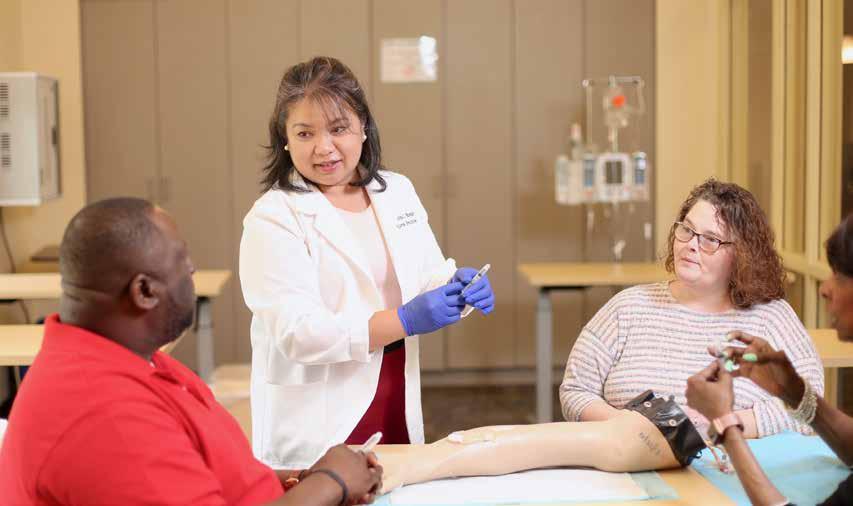
Research in this area seeks a customized approach to health that incorporates genomics data, environmental factors, and lifestyle information to personalize and integrate treatment for individual patients, improving health outcomes and reducing health disparities.
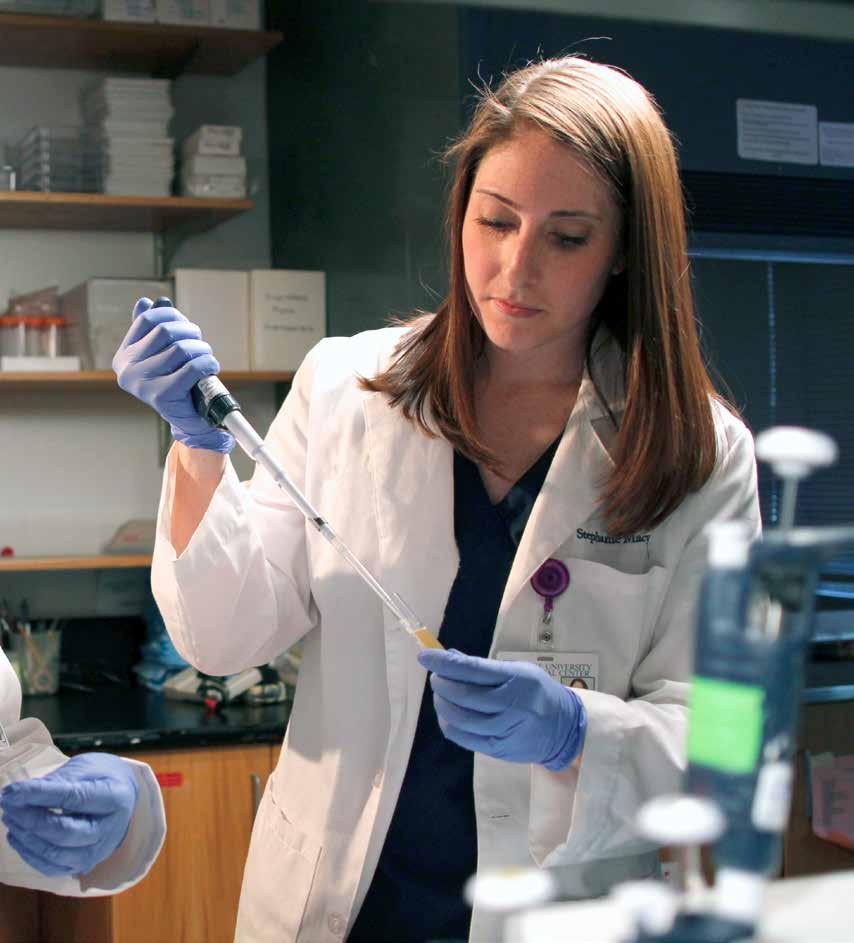

3.
CUSTOMIZING PATIENT CARE
GOAL:
Personalize health care by incorporating genomics data, environmental factors, and lifestyle to improve health outcomes and patient care
Given their frontline positions in the delivery of care, nurses are uniquely positioned to observe results of treatments and interventions and provide patients with crucial knowledge and skills to improve their health and well-being. Through targeted research, our nurse researchers are using precision health as a mechanism to create discoveries and innovations that improve health outcomes, shape health policy, and advance nursing practice.
OUTCOME:
Investments in this area will help develop opportunities for the implementation of genomics and other precision health tools to improve patient outcomes.
RESEARCH IN ACTION:
Asthma treatment options Traumatic brain injury recovery Sickle Cell Disease treatment alternatives
CUSTOMIZING PATIENT CARE
Research in Action
Asthma treatment options
More Americans than ever before have asthma, one of the most common and costly diseases in the U.S. It is also the leading cause of chronic disease in children. While there is no cure, it can be managed with proper prevention of asthma attacks and treatment. Julia Walker, PhD, is conducting research aimed at improving current asthma treatments and medications, specifically beta-agonists, the rescue medication inhaled by asthmatics. Excessive use of beta-agonists is associated with clinical worsening of asthma control and increased mortality. Walker is hoping to identify new compounds that would reduce a patient’s pro-inflamatory reaction to the medication. Her research could lead to the discovery of a new way to personalize the treatment and management of asthma.
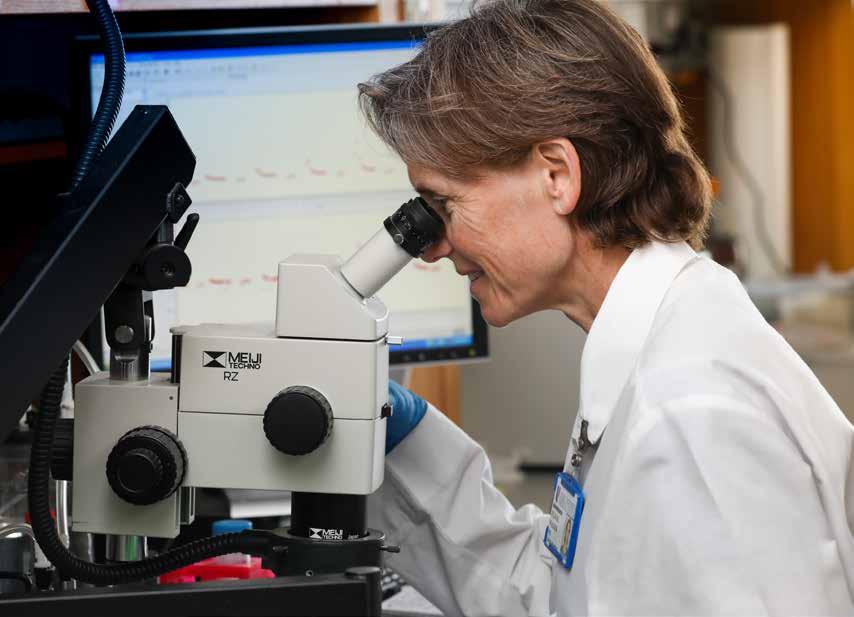
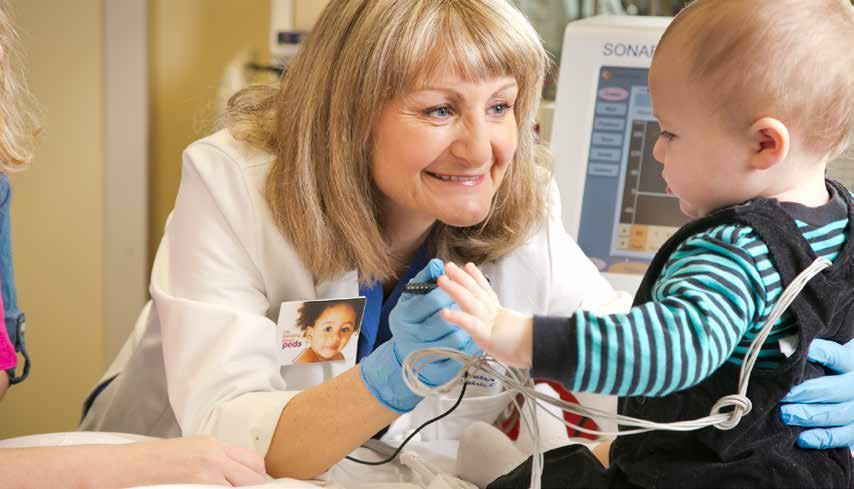
Traumatic brain injury recovery
Traumatic brain injury (TBI) is the leading cause of death and disability in children. In the U.S., one in five children experience a TBI before they reach the age of 16. While working as a nurse practitioner, Karin Reuter-Rice, PhD, CPNP-AC, FCCM, FAAN, noticed a disparity in outcomes as she treated children with similar injuries. Reuter-Rice has found early evidence that the immune system may play an important role in determining who will recover from a TBI and who will sustain long-term impairments. She is conducting a first-of-its-kind study using omic technologies to describe how the immune system disrupts brain recovery and what patient characteristics are more highly associated with immune system dysfunction and neurologic impairment. Determining which children with TBI are at higher risk would allow for the development of rapid diagnostics and personalized treatment strategies. The results of Reuter-Rice’s research will lead to improved, customized approaches to care, not only for children with TBI, but also for those who suffer other sorts of injuries to the brain.
Sickle Cell Disease treatment alternatives
Severe pain is among the most common and deleterious symptoms experienced by individuals with Sickle Cell Disease (SCD). Other than opioids, there are few effective treatments to manage pain in this population. Mitchell Knisely, PhD, RN-BC, ACNS-BC, is working to gain a better understanding of the complexity of pain experiences, as well as psychosocial and biological determinants of pain. Findings from his research will assist clinicians in identifying SCD patients predisposed for high pain burden and allow for improved assessments and personalized pain management therapies.
Research in this area looks at patient care with a special focus on increasing access to health care and building a better understanding of prevention measures and overall wellness.


4.
PREVENTING DISEASE
GOAL:
Seek proactive approaches to patient care with a special focus on increasing access to health care and building a better understanding of prevention measures and overall wellness.
Disease prevention goes beyond taking medication. It looks at all the social determinants of health to promote health and wellbeing across the lifespan. Research in this area focuses on educating and empowering individuals and communities to make changes in their behavior that allow them to develop healthy habits and reduce the risk of developing chronic diseases.
OUTCOME:
Investments in this area will support the use of cutting-edge approaches to interventions, screenings, and the promotion of healthy behaviors that prevent disease and chronic illness.
RESEARCH IN ACTION:
Dietary interventions The role of stress HIV intervention in black women


